Vernal Edge is a non-linear platformer set in a world where a mad scientist’s experiments have caused extra-dimensional destruction, breaking his homeland into an archipelago suspended in a sky filled with unnatural storms. The survivors of this cataclysm have done their best to adapt, aided by a superpower church that uses its flying technology to provide transport but also to oppress as a totalitarian state. I play as Vernal, a young woman who infiltrates the flying islands on a mission of revenge: The mad scientist, Asphodel, is Vernal’s own father, who abandoned Vernal’s mother to die. Armed with the Pulse Edge, a sword of her father’s creation that grants its wielder calamitous powers, Vernal searches the flying islands for her father’s laboratory and a final confrontation from which only one will emerge alive.
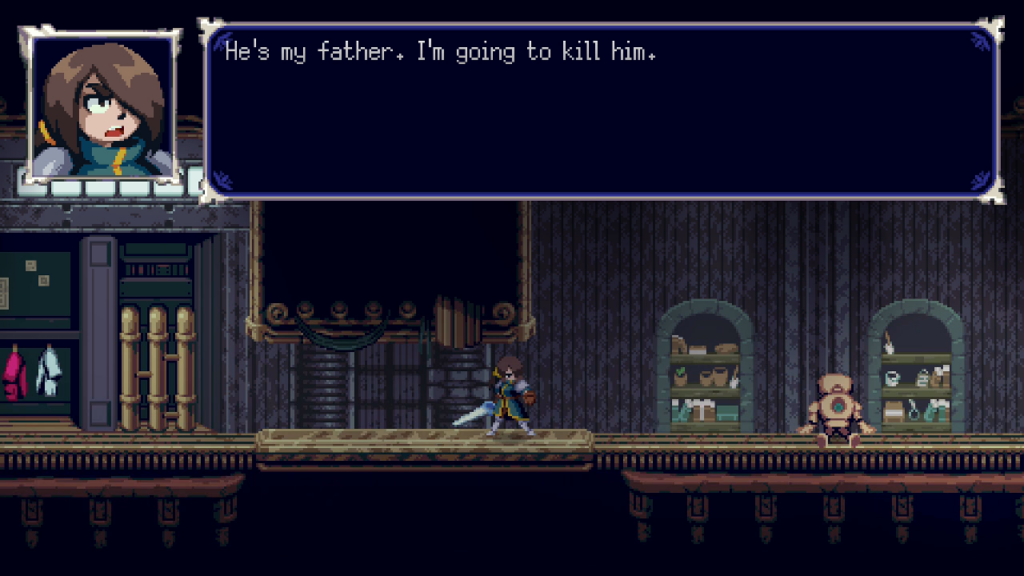
As a non-linear platformer, Vernal Edge does not push too far outside the familiar bounds of its genre. Vernal explores open-ended, side-scrolling environments in search of keys and new abilities. At first, her movement around the world is impeded by locked doors and obstacles she cannot overcome. As Vernal accumulates keys and new abilities, she expands the number of areas to which she has access. Exploring all of the flying islands is the only way to find and confront Asphodel. Putting in the extra bit of effort to thoroughly explore every obscure corner and seemingly empty room rewards Vernal with collectables that improve her health and magic totals, setting her up for success against her father and the other dangers that lurk around the flying islands.
The player character’s movement abilities are where Vernal Edge chooses to be unconventional. Vernal never discovers a proper double jump ability. Instead she learns to add additional jumps or bursts of momentum on top of her other abilities. Early on, she can kick off from walls or conveniently placed lanterns to give her the extra airborne mobility needed to reach higher platforms. Later, she can add an extra thrust in any direction to the end of a lateral air dash. These extra requirements added to jumping can make even simple platforming sequences surprisingly frustrating and unconventional. If there isn’t a nearby lantern to leap from or a wall in just the right configuration, a platform that appears within Vernal’s grasp may prove just out of reach.
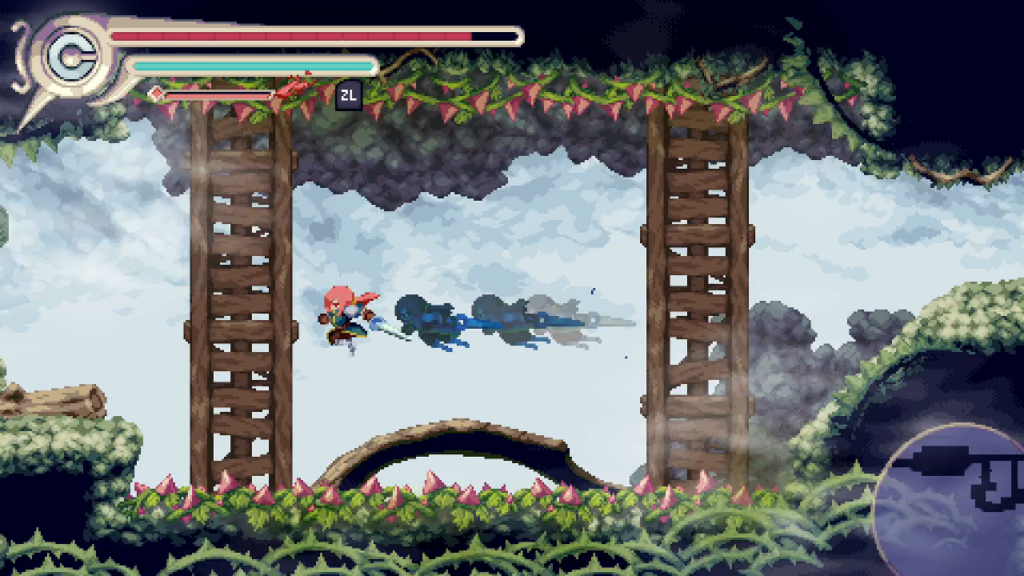
Platforming difficulty is further exacerbated by the complicated rules that govern Vernal’s additional jumps. Some platforming actions refresh Vernal’s abilities and others do not; she can jump back and forth between lanterns all day, but can only jump against a wall once, except in situations where the wall jump is refreshed by another type of jump. Keeping track of all the different exceptions to the jumping limitations becomes a discouraging headache by the time credits roll. Completing the most intricate platforming challenges does not feel intuitive. It feels like experimental probing, testing the bounds of what the arcane jumping rules allow the player character to get away with.
All of these platforming challenges are spread across more than a dozen islands floating in the sky. In a sight that surprises when I first see it, Vernal travels between these islands on a flying ship through a small, fully explorable three dimensional space. Each island is rendered as a jagged and distinctive polygon, looking like it really has been ripped from the earth thousands of feet below and left suspended impossibly in midair. These airship traversal sequences, though brief, add authenticity to Vernal Edge’s retro stylings, feeling like they’ve been lifted from a 32-bit videogame, the last era of design that really experimented with mixing sprite-based two-dimensional environments with polygonal, three-dimensional ones.
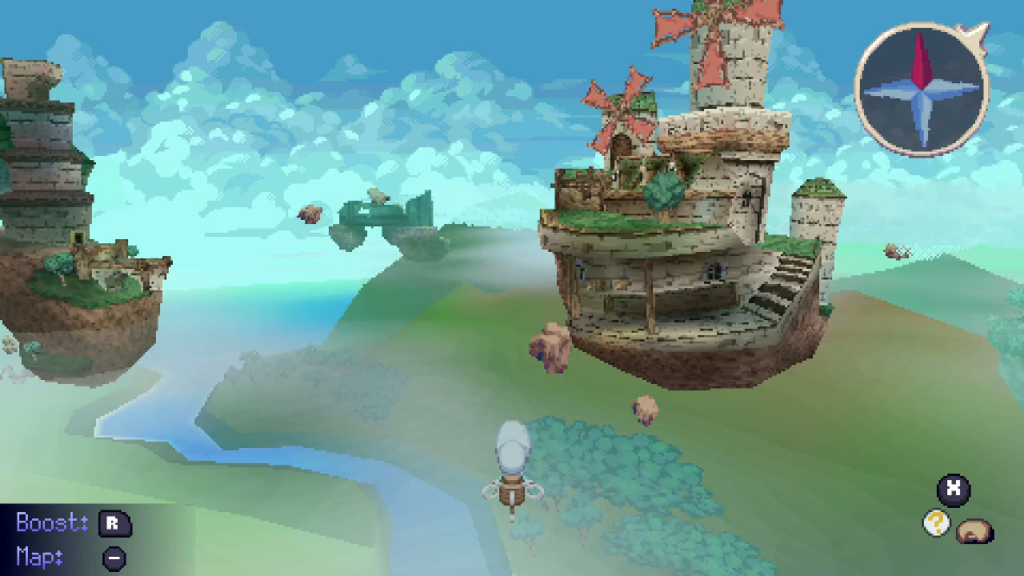
Each flying island in the archipelago supports a different environment for Vernal to explore. Two are cities where the surviving populace are clustered. Vernal may visit these centers to get advice and spend money on upgrades. Other islands are small, containing a single simple activity. A shattered tower contains an arena where Vernal fights a wave of enemies on each floor. Nearby is a small island where an enterprising character has set up a ball-hitting carnival game. Both activities are optional but reward Vernal with useful upgrades if she can overcome their challenges.
The majority of the islands contain small explorable areas that conceal the compasses Vernal needs to reach Asphodel’s hidden lab. Each island has a particular twist that makes them stand out. In the Foggy Ruin, Vernal is sent back to its entrance if she gets enveloped in the thick layer of fog that blankets the island. To clear away the fog and progress to the island’s heart, she must locate melodies hidden in the environment and play them on the bells that dot the ruins. In the Fungal Ruins, Vernal absorbs mushroom spores which affect her mass, using them to solve puzzles that alternately require massive leaps and heavy landings. These unique mechanics give some welcome variety to Vernal’s search.
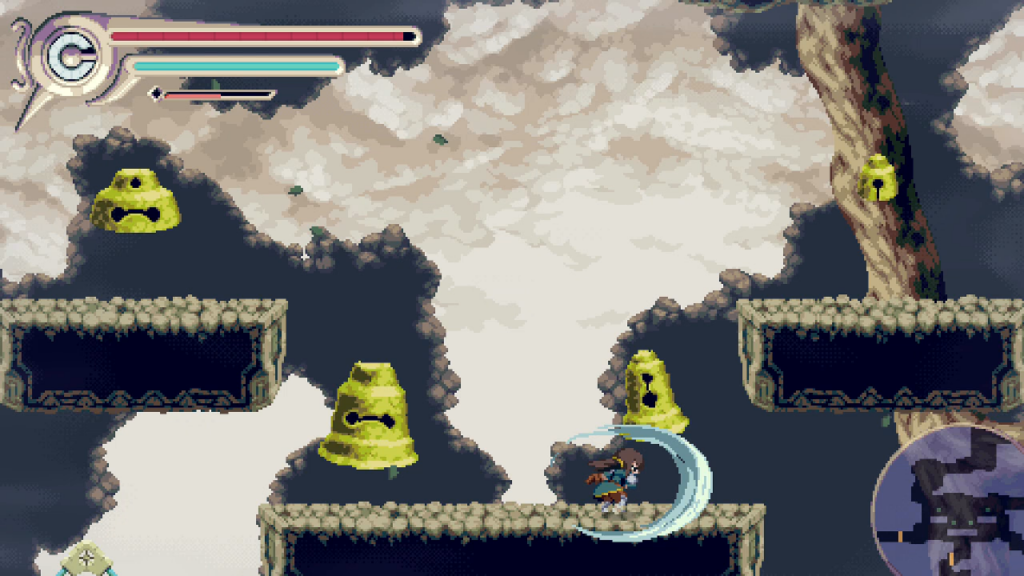
Because so many of Vernal Edge’s environments are divided up into different islands, its world feels truncated and detached. Instead of one big, interconnected, cohesive world to explore non-linearly, Vernal’s search for her father involves brief visits to every nearby island with the hope she may find something new to do there. These visits often end prematurely when I see Vernal lacks the tools she needs to accomplish anything. Even when she does have the required tools, her visits feel perfunctory and unsatisfying.
In theory, these many flying islands still represent a non-linear world. I have many choices as to the order they may be explored and finding an order that works requires persistence and experimentation. In practice, since Vernal travels to so many different locations only to discover there is nothing she can yet do there, her journey feels meandering and unrewarding. Vernal Edge is not the first non-linear platformer I’ve seen try a truncated map design, and it is not the first I’ve seen fail at making it engaging. Vernal Edge is the worst kind of non-linear platformer.
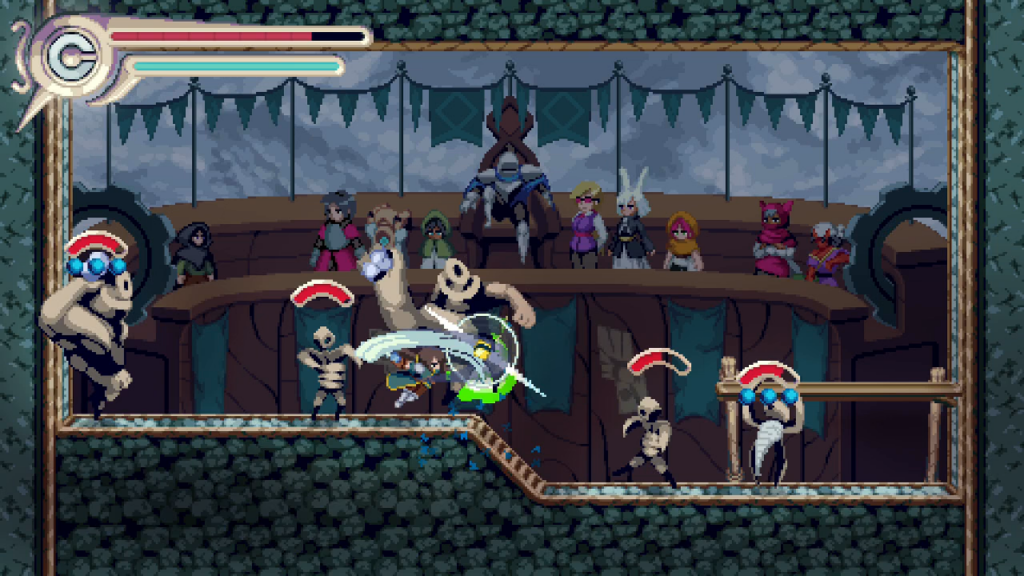
While exploring the islands, Vernal is regularly thrust into combat with groups from two hostile forces that patrol them. Asphodel’s servants are magically-powered robots called Shells who attack with magic missiles and the crushing weight of their jagged bodies. Agents of the Church also pop up on many islands, including knights wielding medieval weaponry and priests who bombard Vernal with projectiles they seem to conjure from their faith. Some enemy groups are visible, waiting for Vernal to try to pass through the area. Most are invisible until they appear to attack Vernal when she enters certain spaces, trapping her in with barriers that do not dissipate until all her foes are dispatched.
Vernal’s options for defending herself show the same sort of unconventional thought put into her platforming abilities. Her primary weapon is the Pulse Edge, a small and apparently unremarkable sword. Basic swings from this weapon deal tiny fragments of damage. More useful is a charge attack. When I hold down the attack button, Vernal accumulates power in the Pulse Edge. Unleashing this power on enemies not only deals more damage than basic attacks, it also removes the stagger points visible beneath their health meters. Stagger points can also be removed by blocking telegraphed attacks and reacting with a counterattack. Removing all of an enemy’s stagger points briefly stuns them. Most fights, including boss fights, come down to strategically whittling down an enemy’s stagger meter so Vernal may attack without fear of retaliation.
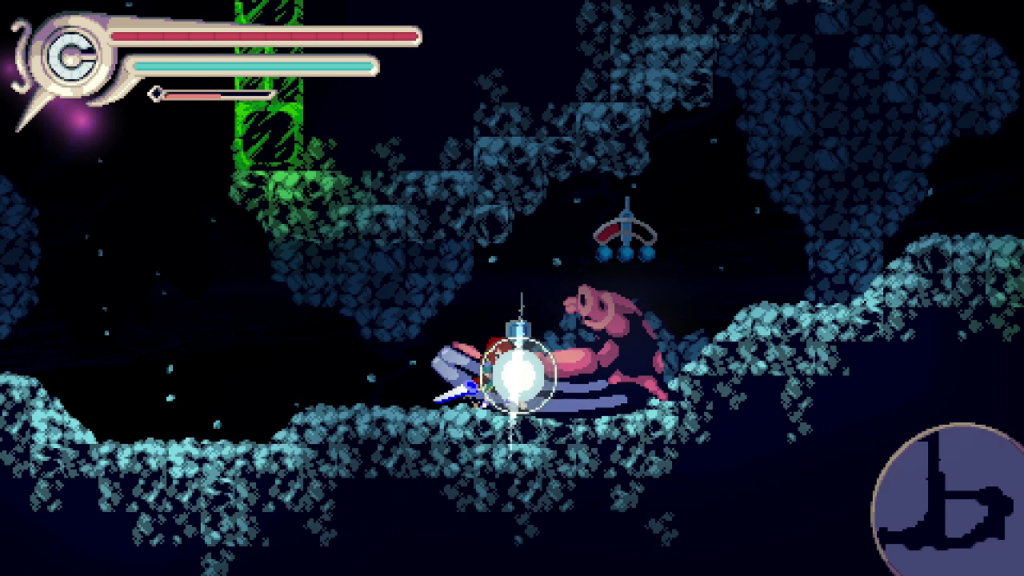
Aside from the Pulse Edge, Vernal has many choices for what she carries into battle. Memories are discs that grant useful passive abilities. Some are conveniences, like Sense of Direction which affixes a minimap to the screen’s corner. Others are more impactful, fundamentally changing how Vernal handles in combat, like Perfect Release which adds additional damage to her charge attacks if they are released with precise timing. One of the main collectables Vernal discovers increases her memory capacity, allowing her to equip more discs. There’s not enough to equip every memory but there’s plenty to create interesting and strategic combinations that can reforge Vernal into different kinds of fighters.
The other way Vernal may be customized is her spell loadout. Like memories, spells are found scattered across the islands. Most are variations on different kinds of projectiles, either flying across the screen at different angles, homing in on enemies, or swirling defensively around Vernal. Though they lack the Pulse Edge’s power, Vernal is still encouraged to use them regularly. She briefly loses the ability to cast spells when her mana meter empties, but it immediately begins recharging. After a few seconds spellcasting may resume. This system smartly keeps spellcasting from nullifying melee combat while still encouraging regular use.
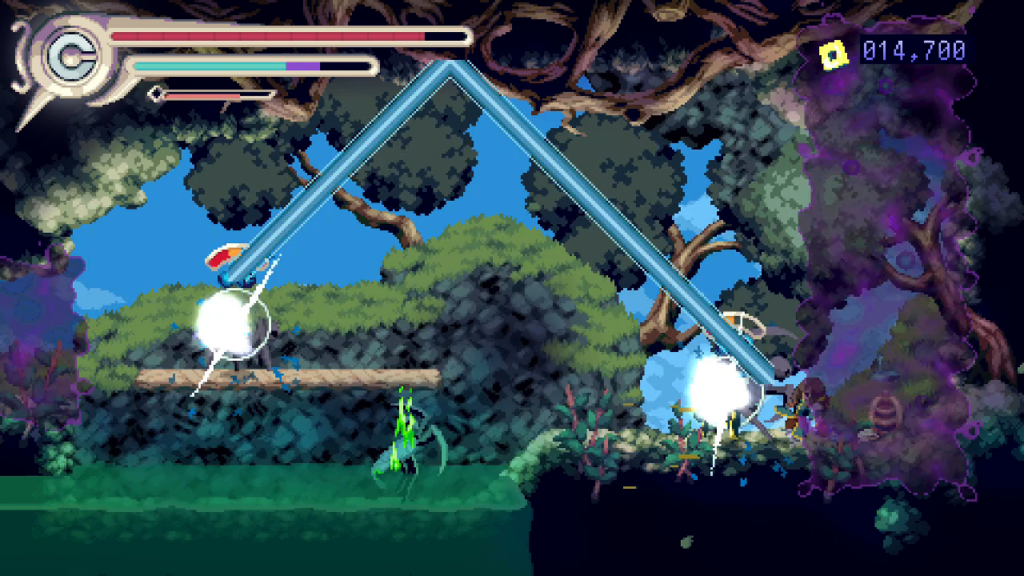
The biggest innovation Vernal Edge brings to familiar side-scrolling combat is how Vernal heals. Instead of the expected limited-use potion or healing magic, Vernal uses a power called Pulse. By pressing the Pulse button, Vernal places a mark on an enemy. Pressing the Pulse button again in conjunction with a direction of the joystick unleashes different kinds of attacks. These attacks home in on the marked enemy and their impact causes healing orbs to sprout from their body which automatically return to Vernal.
Pulse is limited by a few factors. It can only be activated when Vernal’s Pulse meter is charged by regular attacks. The amount of healing it provides also depends on the type of Pulse attack used. These systems keep the combat in a state of constant tension. The safest Pulse abilities which hit from a distance provide the least healing, while the riskiest attacks that send Vernal whirling in to a face-to-face clash provide the most. The riskiest moves provide the greatest kickbacks while the safest often don’t provide the healing Vernal needs to survive the next big attack.
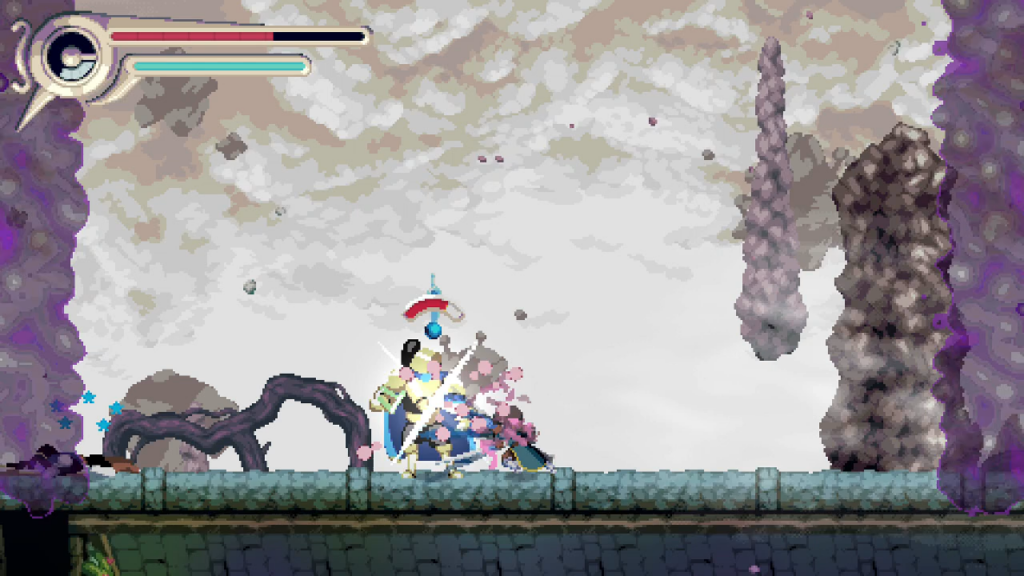
The Pulse Edge already feels like it deals scratch damage to most enemies. This sense of weakness is compounded by the sound effects. Vernal’s sword swings make wispy, barely audible sounds when they impact enemies, as though she is swinging a stalk of dry wheat instead of one of her father’s most terrible creations. This aural inconsequentiality extends to the entire videogame. On the Switch version that I play, at least, I have to turn the volume up to twice its normal level to hear anything at all. Sound design is an element that is easy to ignore until I encounter it done badly. Vernal Edge’s sound design is among the worst in recent memory I can recall.
The flying islands Vernal explores feel like they should be full of life to experience and so I am concerned that I have barely described them at all. This is for the simple reason that for all the time I spend in the islands’ inhabited and abandoned areas, I never really get a sense of the people who live there now and those who lived there in the past.
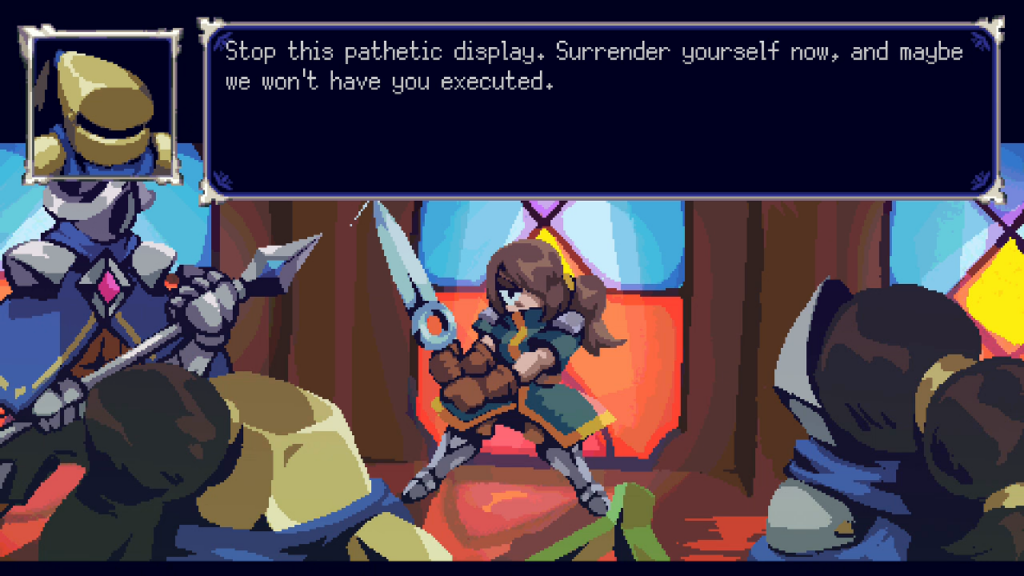
The Church is the standout example of my failure to connect with Vernal Edge’s world. Their most important details are apparent. They are the military might in the flying islands, they are unafraid to throw their muscle around to have their way, and they get away with it because they operate the flying ships that let people get around. Beyond these conflict-driving factors, I can’t tell much. What, exactly, do they worship? How does this set them against Asphodel? Why would they treat Vernal with similar violent opposition instead of attempting to recruit her for their mutual goals? I can determine the answer to none of these questions.
The Church exists as a secondary antagonistic force so Vernal has more to fight than just her father’s army of Shells. They’re generic, faceless, and empty. That also describes the entirety of Vernal Edge’s world.
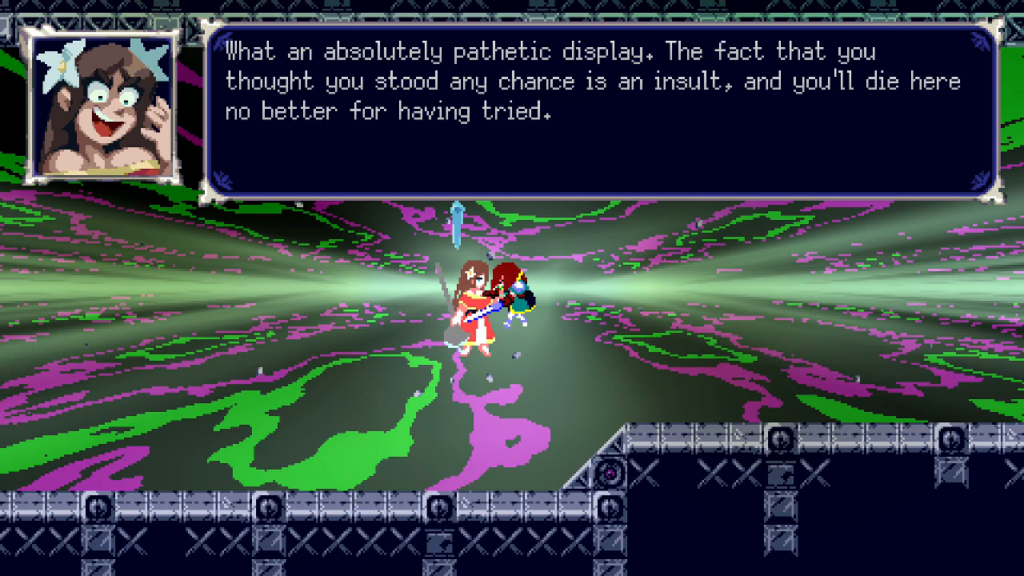
All of Vernal Edge’s strengths are beset by counterbalancing weaknesses. Its archipelago of flying islands is an interesting and fertile setting for non-linear platforming adventures; most of the islands are small and they never come together to form a cohesive and dynamic world. Its combat systems are deep and challenging without becoming punishing; Vernal’s Pulse Edge feels a little too weak, which is compounded by poor sound design failing to underscore the effectiveness of her attacks. The narrative has an interesting backstory and is driven by a compelling conflict; a lack of clear details about the factions and characters means none of it really comes alive. The more I play Vernal Edge, the more I do come to enjoy it, but it takes far too much effort to tease out those kernels.